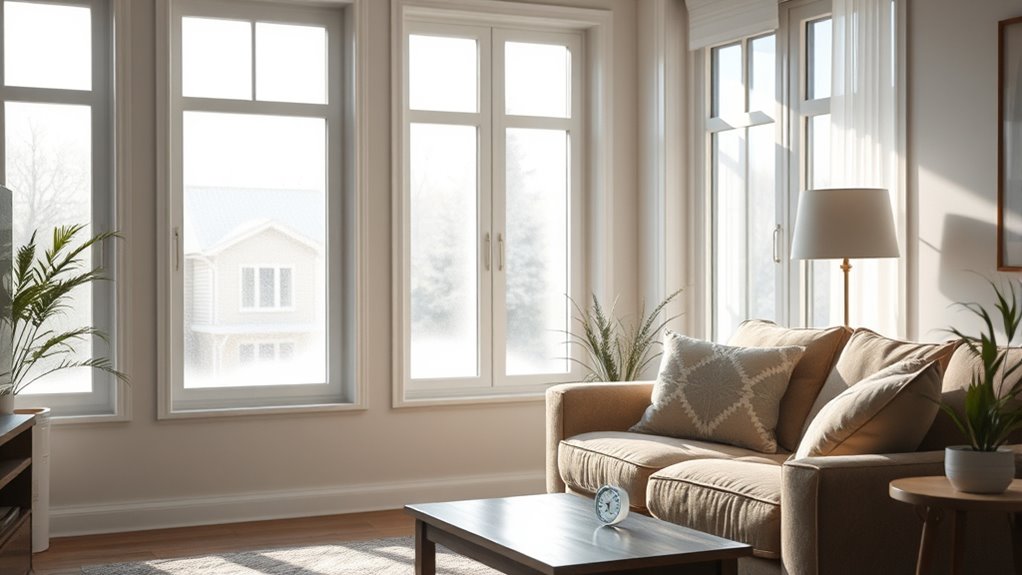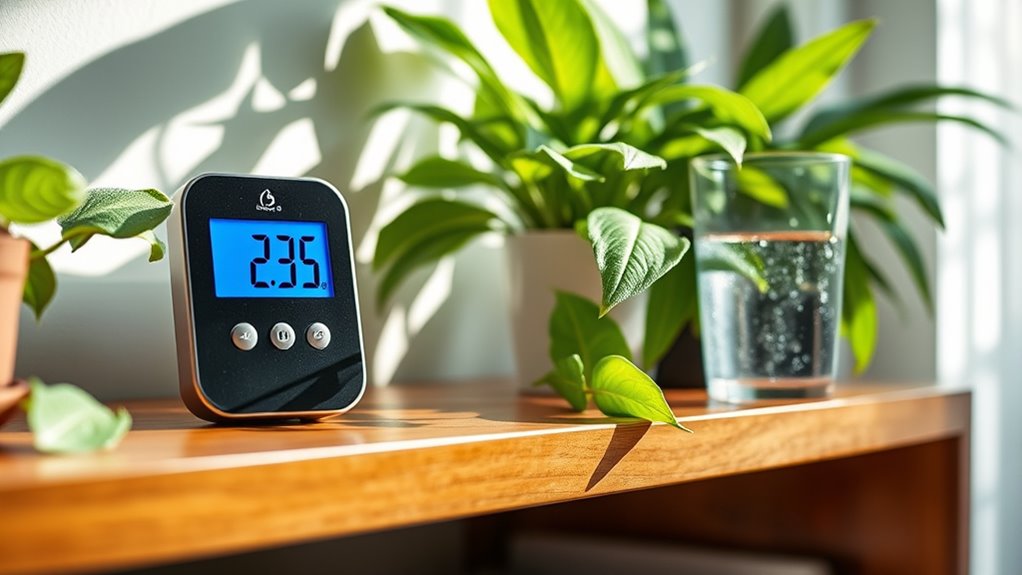Excessive humidity quietly causes mold, attracts pests, and damages your home’s structure, all while impacting your health. If you notice damp spots, musty odors, or condensation, your home may be out of balance. You can control this by monitoring moisture levels, opening windows, using exhaust fans, and drying clothes outdoors. For severe issues, professional help might be necessary. Keep going to discover simple, effective ways to address this hidden problem before it worsens.
Key Takeaways
- Excess humidity fosters mold, mildew, pests, and structural damage, often going unnoticed until serious issues arise.
- Signs include damp spots, musty odors, warped furniture, and condensation, indicating poor humidity control.
- Regular monitoring with hygrometers helps maintain ideal indoor humidity between 30-50%.
- Natural methods like ventilation, exhaust fans, and moisture absorbers effectively reduce excess moisture.
- Seek professional help if mold persists, condensation worsens, or health symptoms appear despite natural measures.
Understanding the Hidden Dangers of Excessive Humidity

Excessive humidity can pose serious health and property risks that often go unnoticed. When moisture levels are high, mold and mildew thrive, releasing spores that can trigger allergies, asthma, and respiratory issues. This damp environment also attracts dust mites and pests, further compromising your health. On a property level, persistent moisture weakens walls, ceilings, and furniture, leading to rot and structural damage. Over time, excessive humidity can cause paint to peel and wood to warp, making your home less safe and less attractive. Many people don’t realize that humidity isn’t just uncomfortable—it’s actively damaging your health and your home’s integrity. Recognizing these hidden dangers is the first step toward taking control and creating a healthier living environment.
Signs Your Home Might Be Suffering From Poor Humidity Control

If you notice persistent dampness or a musty smell in your home, it could be a sign that your humidity levels are out of control. You might also see visible mold or mildew on walls, ceilings,, or furniture. Wooden items may warp or crack, indicating excess moisture. You could experience condensation on windows and mirrors, making them foggy often. Additionally, you might feel clammy or sweaty even when you’re not active. These signs point to poor humidity control, impacting your comfort and health. Keep an eye out for:
Watch for dampness, mold, warped wood, condensation, and discomfort to detect humidity issues early.
- Persistent damp spots or water stains
- Musty odors lingering in rooms
- Warped or cracked wooden furniture
- Condensation buildup on glass surfaces
- Unusual mold or mildew growth
Recognizing these signs helps you address the problem early before it worsens. Proper humidity levels can prevent many of these issues and promote a healthier indoor environment.
Simple Steps to Measure and Monitor Indoor Moisture Levels

Monitoring your indoor moisture levels is a straightforward process that can help you catch humidity problems early. To start, use a digital or analog hygrometer, placing it in common living areas like your living room or bedroom. Check the readings regularly—once a week is ideal. Keep a record of the humidity levels to identify patterns. Use the table below to visualize where moisture might be lingering:
| Room Type | Ideal Humidity Range |
|---|---|
| Living Room | 30-50% |
| Basement | 30-50% |
| Kitchen | 30-50% |
| Bathroom | 30-50% |
Regular monitoring helps you stay proactive, ensuring your home stays comfortable and mold-free. Incorporating automation’s role in business intelligence can also help track and analyze your humidity data more efficiently.
Effective Strategies to Reduce and Regulate Humidity Naturally

To naturally reduce and regulate indoor humidity, you can implement simple strategies that don’t rely on mechanical devices. These methods help keep moisture levels balanced without costly equipment. Start by opening windows regularly to promote ventilation and air exchange. Use exhaust fans in kitchens and bathrooms to remove excess moisture. Keep indoor plants to a minimum, as they can increase humidity. Dry clothes outside whenever possible instead of using dryers. Additionally, place moisture absorbers like charcoal or silica gel in problem areas. These natural techniques create a healthier environment, prevent mold, and maintain comfort. Regularly assess and organize your space to identify areas prone to moisture buildup and ensure proper airflow. By combining these approaches, you can effectively control indoor humidity and avoid problems caused by excessive moisture.
When to Seek Professional Help for Severe Humidity Issues

While natural methods can effectively manage moderate humidity levels, some situations require professional intervention. If you notice persistent mold growth despite your efforts, it’s time to call in experts. Severe condensation on windows or walls indicates that humidity levels are out of control and could damage your home’s structure. If you experience musty odors that won’t go away, or if your health worsens with increased humidity, seek professional help promptly. HVAC specialists can assess your ventilation and install dehumidification systems tailored to your needs. Ignoring severe humidity problems can lead to costly repairs and health issues. Additionally, AI-driven diagnostics can assist professionals in identifying underlying causes more accurately. Trusting professionals guarantees that the root causes are addressed effectively, restoring a healthy indoor environment and preventing future problems.
Frequently Asked Questions
Can Humidity Problems Cause Long-Term Health Issues?
Yes, humidity problems can cause long-term health issues. When humidity is too high, mold and dust mites thrive, leading to allergies, asthma, and respiratory problems. On the other hand, low humidity can cause dry skin, throat irritation, and worsen respiratory conditions. You might also develop infections or worsen existing health issues if humidity levels stay out of balance. Managing humidity helps protect your long-term health and well-being.
What Are the Best Natural Dehumidifiers Available?
You should try natural dehumidifiers like charcoal, silica gel, or rock salt. Did you know charcoal can absorb up to 50% of indoor moisture? Charcoal’s porous nature makes it excellent for reducing humidity naturally. Silica gel packs are reusable and easy to place in closets or drawers. Rock salt is also effective and inexpensive—just fill a container, and it’ll help keep your space dry without chemicals.
How Does Humidity Affect Indoor Air Quality?
Humidity directly impacts your indoor air quality by promoting mold growth, dust mites, and bacteria, which can cause allergies and respiratory issues. High humidity makes the air feel damp and uncomfortable, while low humidity can lead to dry skin and irritation. Maintaining ideal humidity levels (around 30-50%) improves comfort and health. Use dehumidifiers, ventilate well, and monitor humidity to keep your indoor air safe and balanced.
Are There Specific Seasons When Humidity Issues Worsen?
Yes, humidity issues tend to worsen during summer and winter. In summer, high temperatures increase indoor moisture from sweating and air conditioning, leading to mold and discomfort. In winter, indoor heating dries out the air, causing dry skin and respiratory issues. You need to monitor these seasonal shifts, control moisture levels, and use dehumidifiers or humidifiers to maintain a comfortable, healthy indoor environment year-round.
Can Plants Help Control Indoor Humidity Levels?
Yes, plants can help control indoor humidity levels. They naturally absorb moisture through their leaves and roots, releasing it when the air is dry. By choosing plants like ferns, peace lilies, or pothos, you can maintain a balanced humidity. Regularly caring for them, including watering appropriately, ensures they effectively regulate moisture in your space, making your environment more comfortable and reducing humidity-related issues.
Conclusion
Don’t let hidden humidity problems silently damage your home and health. By staying vigilant and taking proactive steps, you can create a more comfortable, healthier living space. Regular monitoring and natural solutions often do the trick, but when issues persist, seeking professional help is essential. After all, isn’t your well-being worth addressing these unseen dangers before they escalate? Take action today and breathe easier tomorrow.









